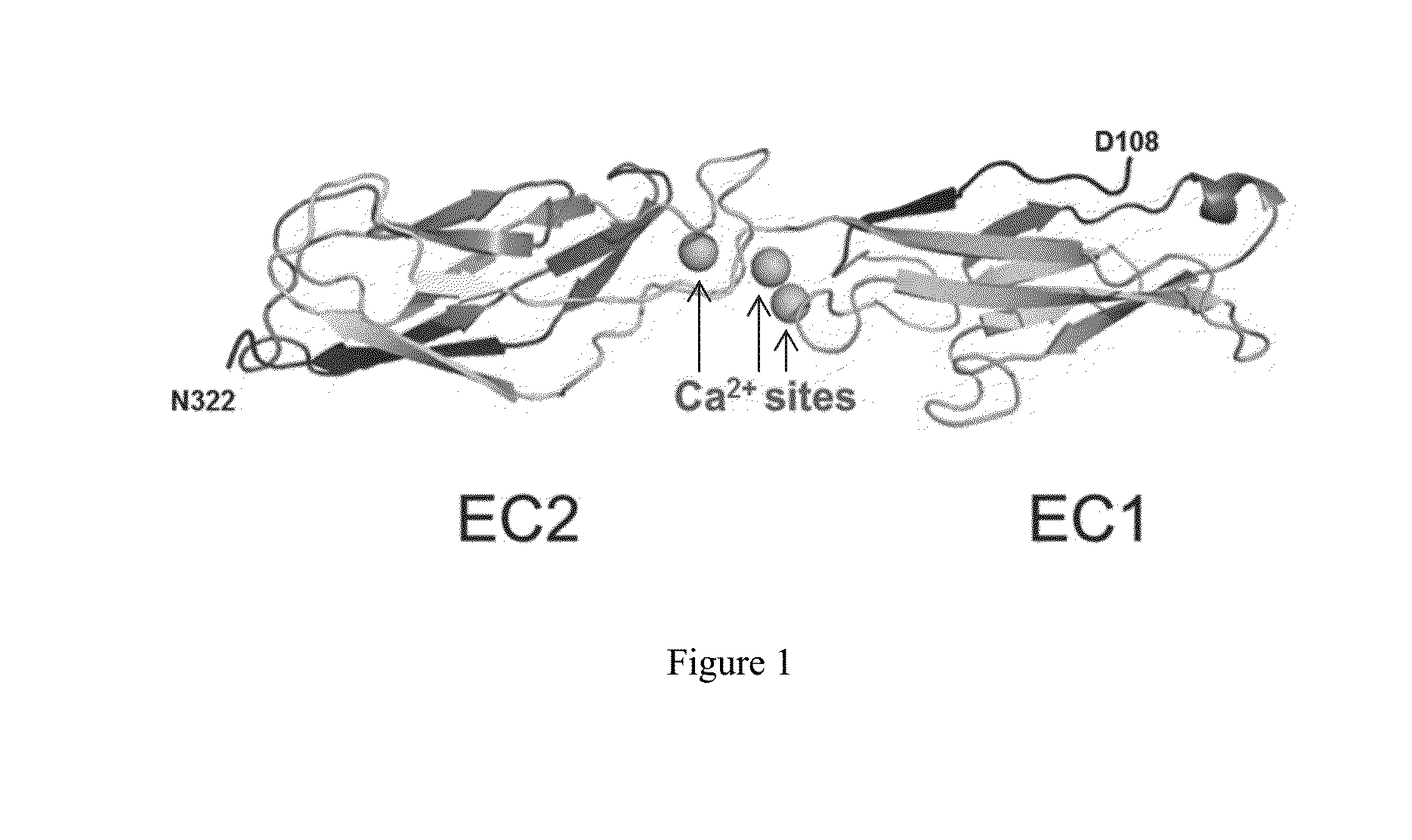Antibody drug conjugates
- Summary
- Abstract
- Description
- Claims
- Application Information
AI Technical Summary
Benefits of technology
Problems solved by technology
Method used
Image
Examples
example 1
Generation of Antibodies
Generation of Expression Constructs for Human, Cynomolgus Monkey, Mouse and Rat P-Cadherin Proteins
[0305]Human, mouse and rat P-cadherin extracellular domains (ECD) were gene synthesized based on amino acid sequences from the GenBank or Uniprot databases (see Table 2 below). Cynomolgus monkey P-cadherin ECD cDNA template were gene synthesized based on amino acid sequence information generated using mRNA isolated from various cyno tissues. All synthesized DNA fragments were cloned into appropriate expression vectors with C-terminal hexa-histidine tag (SEQ ID NO: 130) to allow for purification.
TABLE 2Amino Acid Sequence Information for P-cadherinSEQNameDescriptionAccession Number or SequenceID NOHuman P-Human CDH3, residuesNM_001793.4, NP_001784121cadherin (CDH3)108-652-TAGD1-5Rat P-cadherinRat CDH3, residues 100-NM_053938.1, NP_446390122(CDH3) D1-5647-TAGMouse P-cadherinMouse CDH3 isoform a,NM_001037809.5, NP_001032898123(CDH3) D1-5residues 100-647-TAGCynomolg...
example 2
X-Ray Crystallographic Structure Determination of the Human P-Cadherin EC1_EC2 and of its Complex with the NOV169N31Q Fab
[0340]The three dimensional structure of human P-cadherin was hitherto unknown. The crystal structure of a human P-cadherin ECD (extracellular domain) fragment (first two N-terminal cadherin-repeat domains, or EC1_EC2, amino acids 108 to 324, SEQ ID NO: 2, Table 1) as well as its complex with the Fab fragment of NOV169N31Q (Table 1) was determined. As detailed below, human P-cadherin EC1_EC2 was expressed, refolded, purified and crystallized. In addition, purified human P-cadherin EC1_EC2 was mixed with the NOV169N31Q Fab to form a complex which was also subsequently purified and crystallized. Protein crystallography was then employed to generate atomic resolution data for human P-cadherin EC1_EC2 in the free state and bound to the NOV169N31Q Fab to define the epitope.
Protein Production of Human P-Cadherin EC1_EC2 and NOV169N31Q Fab for Crystallography
[0341]The am...
example 3
Generation and Characterization of P-Cadherin Antibody Drug Conjugates
Preparation of the DM1 Conjugates by One-Step Process
[0360]Antibodies to P-cadherin were diafiltered into a reaction buffer (15 mM potassium phosphate, 2 mM EDTA, pH 7.6) via Tangential Flow Filtration (TFF#1) prior to the start of the conjugation reaction. Subsequently, antibodies (5.0 mg / mL) were mixed with DM1 (5.6-fold molar excess relative to the amount of antibody) and then with SMCC (4.7 fold excess relative to the amount of antibody). The reaction was performed at 20° C. in 15 mM potassium phosphate buffer (pH 7.6) containing 2 mM EDTA and 10% DMA for approximately 16 hours. The reaction was quenched by adding 1 M acetic acid to adjust the pH to 5.50. After pH adjustment, the reaction mixture was filtered through a multi-layer (0.45 / 0.22 μm) PVDF filter and purified and diafiltered into a 20 mM histidine buffer (pH 5.6) containing 8.22% sucrose using Tangential Flow Filtration (TFF#2). The instrument param...
PUM
| Property | Measurement | Unit |
|---|---|---|
| Fraction | aaaaa | aaaaa |
| Molar density | aaaaa | aaaaa |
| Molar density | aaaaa | aaaaa |
Abstract
Description
Claims
Application Information
 Login to View More
Login to View More - R&D
- Intellectual Property
- Life Sciences
- Materials
- Tech Scout
- Unparalleled Data Quality
- Higher Quality Content
- 60% Fewer Hallucinations
Browse by: Latest US Patents, China's latest patents, Technical Efficacy Thesaurus, Application Domain, Technology Topic, Popular Technical Reports.
© 2025 PatSnap. All rights reserved.Legal|Privacy policy|Modern Slavery Act Transparency Statement|Sitemap|About US| Contact US: help@patsnap.com



